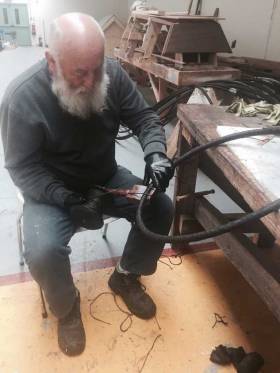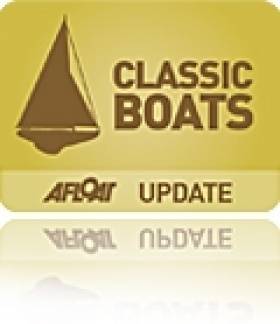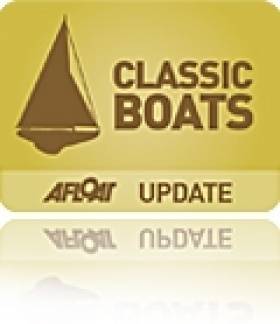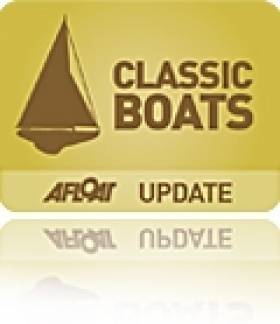Displaying items by tag: Historic
Historic Ketch Ilen’s Restoration Moves on From Broad Strokes to Detail Work
With the hull of the 56ft 1926-built Conor O’Brien ketch Ilen now restored and painted in the building shed in Oldcourt near Baltimore, attention shifts increasingly to the long list of detail work that is needed to complete the project writes W M Nixon.
Much of this is ideally suited to the facilities available in the Ilen Boat Building School in Limerick, where director Gary MacMahon and his team have assembled a group of all the talents for teaching and learning. These days, the evocative aromas and sounds of traditional ship-building and its associated tasks permeate both the school in the city, and the building shed beside the Ilen River.
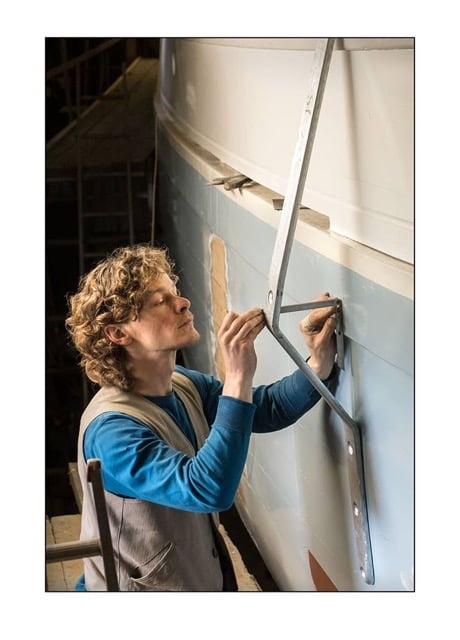 In the Old Cornstore on the River Ilen near Baltimore, Matt Dirr works towards a perfect fit for the classic chainplates (above and below). Photos: Kevin O’Farrell
In the Old Cornstore on the River Ilen near Baltimore, Matt Dirr works towards a perfect fit for the classic chainplates (above and below). Photos: Kevin O’Farrell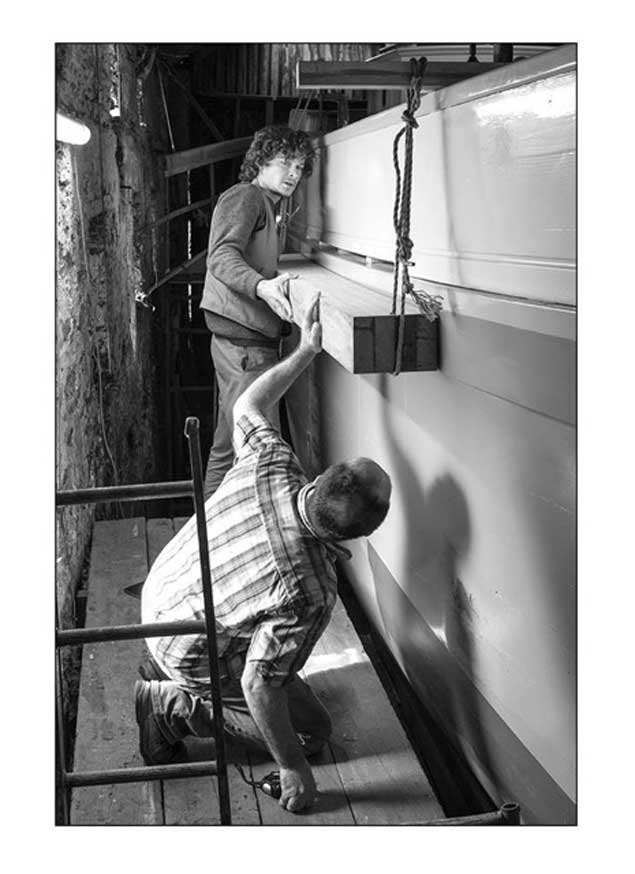
Conor O’Brien’s global circumnavigation in the 42ft ketch Saoirse in 1923-25 inspired the Falkland Islanders to ask for a larger sister-ship to the same concept for their inter-island communications vessel, and the resulting Ilen was able - among other things - to transfer up to 200 sheep on the inter-island channels.
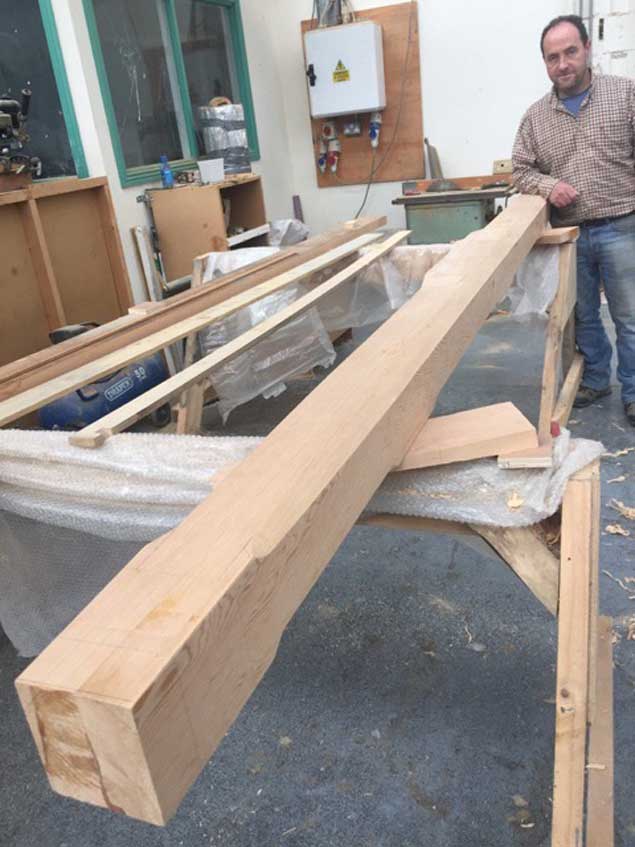 In Limerick, James Madigan shapes a new Douglas Fir cathead Photo: Gary MacMahon
In Limerick, James Madigan shapes a new Douglas Fir cathead Photo: Gary MacMahon
With her larger size, she also enabled O’Brien and master shipwright Tom Moynihan of Baltimore to give more space to the steering gear. As O’Brien later admitted, they’d tried to pack so much into Saoirse’s compact 42ft hull that her steering wheel was awkwardly placed for long spells at the helm, so in Ilen they made a point of installing a more substantial arrangement which can now be seen re-created in Limerick.
In both the school in the city and the Old Cornstore in Oldcourt, it’s an immersive maritime experience of being transported back in time to the 1920s and far beyond.
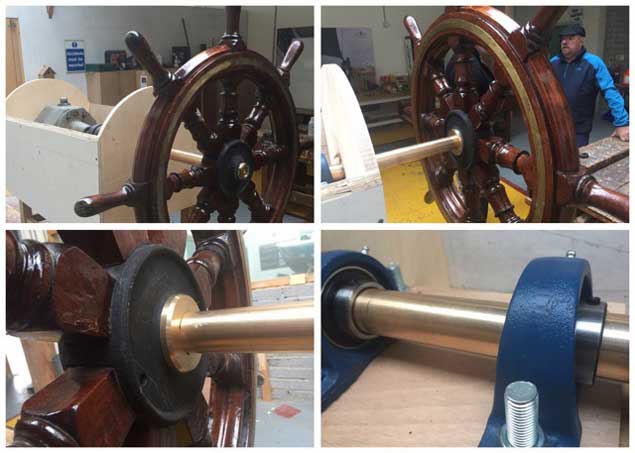 Four angles on the re-created steering gear Photo; Gary McMahon
Four angles on the re-created steering gear Photo; Gary McMahon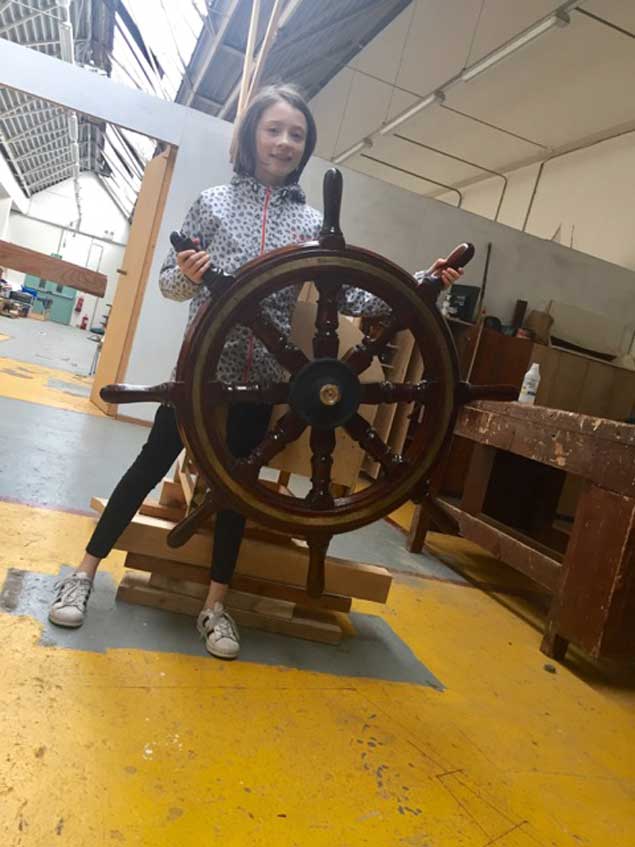 Molly MacMahon with the new steering wheel. In his subsequent books about seagoing gear and equipment, Conor O’Brien stipulated that the ideal size for a steering wheel is 42 inches. This is a “thin” 42 inches – as big as can be fitted. Photo: Gary MacMahon
Molly MacMahon with the new steering wheel. In his subsequent books about seagoing gear and equipment, Conor O’Brien stipulated that the ideal size for a steering wheel is 42 inches. This is a “thin” 42 inches – as big as can be fitted. Photo: Gary MacMahon
70 Historic Craft For British Classic Week 2015
#historiccraft – Already more than 70 entries have registered for Panerai British Classic Week 2015, which will take place from 18th – 25th July at Cowes Yacht Haven.
Leading the international visitors are French America's Cup legend Bruno Troublé who will skipper 'Jour de Fête', a "Q Boat" designed by Paine/Burgess to Herreschoff's Universal Rule and built by Lawley in Boston in 1930, and the awe inspiring 'Eleonora', which at just shy of 50m long is the largest yacht entered to date and was built to a Nathaniel G Hereschoff schooner design by Van de Graaf in 2000.
The oldest yachts competing include David Sherriff's delightful 1897 Fife Gaff Cutter 'Jap', winner of Panerai British Classic Week in 2012, Richard Oswald's 1902 Fred Shepherd Gaff Schooner 'Coral', and Pelham Olive's 1903 Alfred Mylne Gaff Cutter 'Kelpie'.
The regatta attracts classic yachts of all shapes and sizes and the smallest currently entered is Michael Frith's 1964 Kroes en Zonen designed 7.4m Bermudan Sloop 'Blue Eagle', whilst the largest are 'Eleonora" and the spectacular 29m long 1911 William Fife Gaff Cutter 'Mariquita', owned by John Caulcutt, Jamie Matheson and Stephen Hemsley.
Giovani Belgrano's defending Panerai British Classic Week champion Whooper, comes to the regatta fresh from overall victory in the IRC Classes at the JP Morgan Asset Management Round the Island Race. Other past winners of the event hoping to add their name to the event's prestigious trophies again include David Murrin's 1955 Laurent Giles Sloop 'Cetewayo', Jamie Matheson's 'Opposition', the 1971 Sparkman & Stephens sloop built by Lallows for British Prime Minister Ted Heath, and Murdoch McKillop's 1931 Fife designed International 8 Metre 'Saskia'.
The Modern Classic Classes, for the Spirit Yachts and modern yachts built with the appearance of a classic, will be hotly contested as always with Stephen Jones's self designed 'Meteor', Regatta Chairman Sean McMillan's Spirit 52 'Flight of Ufford' and Stephen O'Flaherty's 'Soufriere', which famously starred in the 2006 James Bond movie Casino Royale, heading the list of possible Modern Classics winners.
Whilst the boats remain the stars of the show, there are nonetheless always plenty of human stars in attendance too. Making his first appearance at Panerai British Classic Week is double International Moth World Champion Simon Payne, who will be swopping his foiling speed machine for his extremely elegant but somewhat slower Nicholson Jolina 35 'Damian B'. TV star and well-known classic boat enthusiast Griff Rhys-Jones will make a welcome return to the regatta aboard his 1948 Olin Stephens designed Bermudan Yawl 'Argyll', and as always the crew lists will feature a host of internationally renowned sailors.
Also playing a key role in the regatta's success are the event sponsors led by Title Sponsor Officine Panerai, and supported by Official Partner Sponsor EFG, Official Media Partner Classic Boat, Race Day Sponsor Sandeman Yacht Company, Official Rum Supplier Mount Gay Rum and Official Clothing Supplier Zhik.
Royal Yacht Squadron Racing will run a six race series plus the special Around the Island Race sponsored by EFG International on Monday 20th July. The ever-popular Ladies Race will be held on Wednesday 22nd July and the regatta will conclude with the Parade of Sail past the Royal Yacht Squadron and Cowes Green on Saturday 25th July.
Ashore the Panerai Lounge will be the focal point for pre and post sailing gatherings and the social programme includes a Welcome Reception at the Royal Yacht Squadron, the traditional "Open Yachts" Pontoon Party, and the Prize Giving Dinner at Cowes Yacht Haven Events Centre.
#classicboats – The Crosshaven Traditional Sail event on the Irish south coast celebrates twenty years of age this season in Cork harbour when dozens of classic sailboats, traditional currachs and a vintage steam boat will line up at the Hugh Coveney pier in Crosshaven.
The Traditional Sail event takes place on the weekend of Friday 19th to Sunday 21st of June.
The classic regatta is a family favourite for landlubbers and seadogs alike with in-harbour racing, followed by barbeques and music in pubs throughout Crosshaven village all weekend. In keeping with seafaring tradition, there is a pirate theme to the regatta, with prizes for the best dressed pirates, salty seadogs, wenches and young admirals of the fleet.
The line-up also includes kids knot-tying and crab fishing competitions and informative lectures and talks on restoration projects past and present are held for the timber junkies among us! Traditional wooden boats which include Pat's Tanners own Galway Hooker, "An Faoilean" constructed over a century ago in Co. Galway and Ray Heffernans St Bridget built by Tyrells of Arklow are among the craft which will take part.
The fleet will assemble at the Hugh Coveney Pier from Friday evening, June 19th and visitors can see the boats up close by calling by on Friday evening or Saturday morning. Shore side spectators can watch the in-harbour racing from vantage points at Camden Fort Meagher or enjoy the parade of sail from Crosshaven village as the fleet will sail along the Owenabue River on Sunday afternoon.
The event was the brain child of local sailor and Boatyard owner Wietze Bowalda and some local publicans and has enjoyed fleet sizes of in excess of 40 boats. Over the last 20 years the event has been chaired by Mark Bushe and Pat Tanner who are also on the committee for the 20th anniversary celebrations.
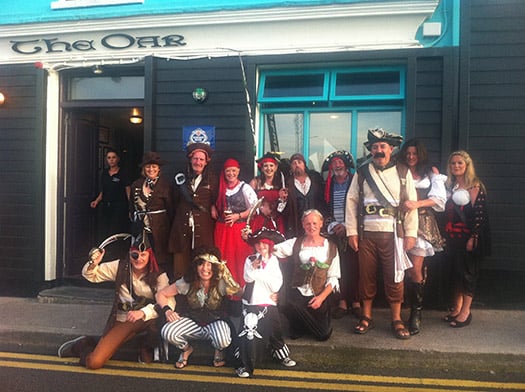
Pirates at the Oar Pub
This year we have engaged the Drascomb Lugger class, the Heir island sloops and we are arranging a cruise in company from baltimore to encourage West Cork based boats to make the journey east. For the shore based, there will be Tall ships on the Hugh Coveney Pier and we are planning a fireworks display on the Saturday night to add to party atmosphere which takes over the village for this weekend each year.
"Crosshaven is a great host village for this classic event" explains event organiser James Fegan "There is excellent sailing waters in Cork harbour and as a spectator if you were to never leave the dock you can still get an appreciation of these classic boats. We have a loyal following of boat owners who come annually to the event from all along the coast.
"There's always a great atmosphere in Crosshaven on this weekend" explained Denis Cronin of Cronin's Pub "Everyone from the kids to the local business owners really embrace the spirit the event. Here in the pub we even exchange our regular glasses for jam jars... because pirates always drinks from jaaaaarrs!"
Drogheda's Tribute To Submarine Pioneer John Philip Holland
#Historic - Last weekend saw the unveiling in Drogheda of a sculpture of the Fenian Ram, the first successful submarine whose designer was connected with the town.
As The Irish Times reports, the modern submarine was pioneered by John Philip Holland, who worked as a teacher in the Boyne-side town before emigrating to the States and developing his submersible ideas for the US Navy.
The rest is history, as Holland's designs formed the basis of all modern submarines we know today.
Strangely enough, his story is entwined with that of another Irishman, Louis Brennan, who invented the world's first practical guided torpedo.
Holland died just weeks before the HMS Pathfinder became the first ship to be sunk by a submarine-launched underwater missile.
But his legacy is not all destruction, and better exemplified by the exploration work being done in the Whittard Canyon by the Marine Institute's unmanned submersible ROV Holland I, named for one of the Irishman's early submarine prototypes.
The Irish Times has more on the story HERE.


























